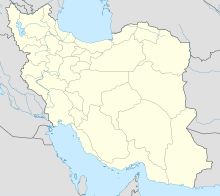Dinawar
Coordinates: 34 ° 35 ′ 0 ″ N , 47 ° 25 ′ 0 ″ E
Dinawar ( Persian دینور) was an important medieval city in western Iran. The ruins of the city lie northeast of the city of Kermanshah in the province of the same name.
It is not known when the city was founded. It has been known at least since the Seleucid Empire . Finds of statues of satyrs and Silenus indicate that the Greek inhabitants of Dinawar worshiped Dionysus here . At the time of the Sasanids , Dinawar was an important fortress on the border of the empire. At the beginning of the 6th century Dinawar was attacked by the Khazars from the Caucasus. Shortly after the Sasanids were defeated by the Muslim Arabs in 642 at the Battle of Nehawend , Dinawar was conquered by the Arabs. They called the city Māh al-Kūfa. Eventually the entire Sasanid Empire was conquered and rearranged. Dinawar became one of the most important and richest cities in the Jibal Province , which encompassed all of western Iran. It was on a fertile plain, irrigated by the Jam-i Dinawar river, and had rich orchards, cornfields and a large bazaar. According to the geographer Ibn Hauqal , Dinawar was smaller than Hamadan , but surpassed Hamadan in terms of wealth and number of scholars. Dinawar was also on the important road from Baghdad to Khorasan .
When al-Muqtadir was caliph , the Muslim empire was in a critical phase. Local rulers revolted against the caliph and split off. Thus the general Mardawi ibn Ziyar, who founded the Ziyarid dynasty, conquered Jibal and Fars. Dinawar fell to him in 931 and thousands of residents died in the process. Afterwards the Dailamite Buyids and the Kakuyids ruled Dinawar. In the 10th and 11th centuries, Dinawar was the capital of the Kurdish Hasanwayhids , who rebuilt the city. Later the city slowly declined in importance, while the neighboring Kermanshah became more important. In 1172 it was plundered by the Oghusian Seljuks and could not find its way back to its old size. Timur then completely devastated the city at the end of the 14th century, so that it was never rebuilt.
sons and daughters of the town
- Ad-Dīnawarī - botanist, historian, geographer, astronomer and mathematician of the 9th century
source
- Dinawar . In: Ehsan Yarshater (Ed.): Encyclopædia Iranica (English, including references)
- Article Dīnawar by Lockhart in The Encyclopaedia of Islam. New Edition
